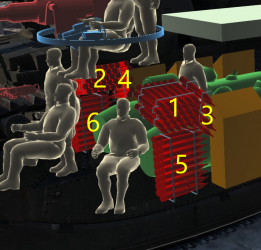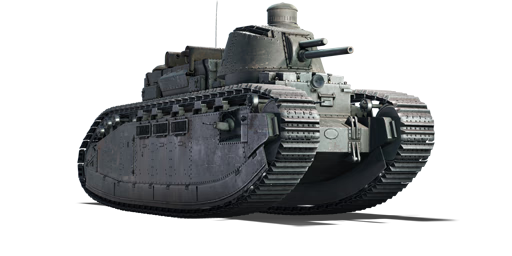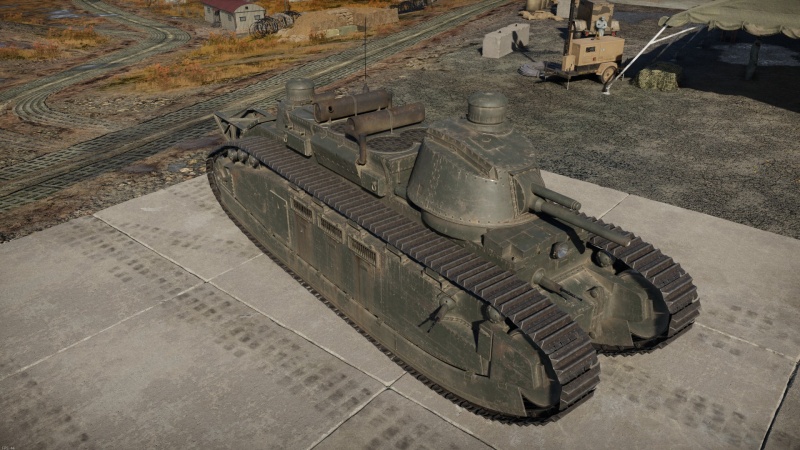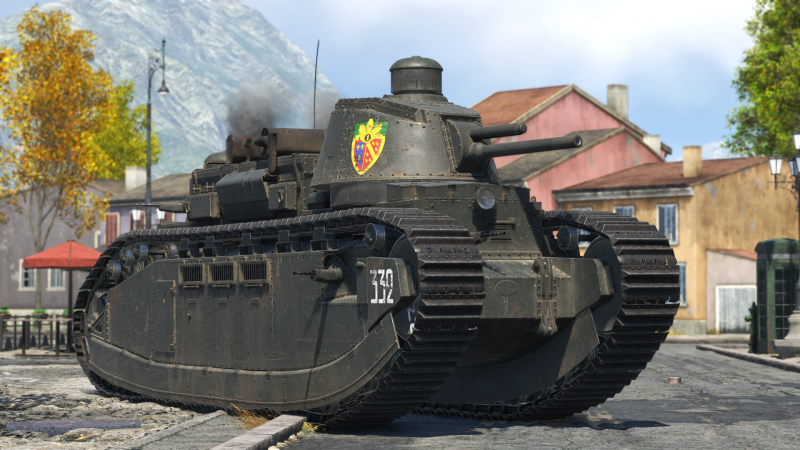Difference between revisions of "2C"
(New Description Project - France Priority: Tanks - Char 2C) (Tag: Visual edit) |
m (Minor updates) (Tag: Visual edit) |
||
| Line 11: | Line 11: | ||
== Description == | == Description == | ||
<!-- ''In the description, the first part should be about the history of the creation and combat usage of the vehicle, as well as its key features. In the second part, tell the reader about the ground vehicle in the game. Insert a screenshot of the vehicle, so that if the novice player does not remember the vehicle by name, he will immediately understand what kind of vehicle the article is talking about.'' --> | <!-- ''In the description, the first part should be about the history of the creation and combat usage of the vehicle, as well as its key features. In the second part, tell the reader about the ground vehicle in the game. Insert a screenshot of the vehicle, so that if the novice player does not remember the vehicle by name, he will immediately understand what kind of vehicle the article is talking about.'' --> | ||
| − | The '''Char 2C''' is a French heavy tank developed after World War I that was eventually designated as a super-heavy tank. It was developed during World War I but did not enter service until after the war was over. In terms of overall volume or physical dimensions, it was the largest operational tank ever built. The Char 2C was the first super-heavy tank to enter service; a super-heavy tank is one that was purposely designed to be significantly larger than conventional tanks at the time. When fully equipped, the Char 2C weighed 69 tonnes, due in part to its armour, which was among the thickest of World War I tanks, but also to its vast size | + | The '''Char 2C''' is a French heavy tank developed after World War I that was eventually designated as a super-heavy tank. It was developed during World War I but did not enter service until after the war was over. In terms of overall volume or physical dimensions, it was the largest operational tank ever built during World War I. The Char 2C was the first super-heavy tank to enter service; a super-heavy tank is one that was purposely designed to be significantly larger than conventional tanks at the time. When fully equipped, the Char 2C weighed 69 tonnes, due in part to its armour, which was among the thickest of World War I tanks, but also to its vast size. The tank required a crew of twelve to operate: a driver, commander, gunner, loader, four machine gunners, a mechanic, electrician, assistant-electrician/mechanic, and a radio operator. Some sources suggest thirteen, most likely on the basis of photos of crews that probably included the company commander. |
Introduced in [[Update "Sky Guardians"]], the Char 2C should be utilized as a breakthrough tank since it is too slow to flank and has a low muzzle velocity main armament to engage distant targets. Its ammunition is powerful enough to knock out practically anything at close range, making it perfect for open-topped and lightly armoured vehicles. Despite its strong on-paper statistics, the Char 2C will struggle to penetrate other heavy tanks. Light tanks from the enemy are equally lethal. They may easily flank around the battlefield and engage you when you are not expecting it due to their great speed. To avoid being isolated and overrun by adversaries, it is critical to always be close to teammates. | Introduced in [[Update "Sky Guardians"]], the Char 2C should be utilized as a breakthrough tank since it is too slow to flank and has a low muzzle velocity main armament to engage distant targets. Its ammunition is powerful enough to knock out practically anything at close range, making it perfect for open-topped and lightly armoured vehicles. Despite its strong on-paper statistics, the Char 2C will struggle to penetrate other heavy tanks. Light tanks from the enemy are equally lethal. They may easily flank around the battlefield and engage you when you are not expecting it due to their great speed. To avoid being isolated and overrun by adversaries, it is critical to always be close to teammates. | ||
Revision as of 19:07, 23 October 2023
| This page is about the French heavy tank 2C. For the other version, see 2C bis. |
Contents
Description
The Char 2C is a French heavy tank developed after World War I that was eventually designated as a super-heavy tank. It was developed during World War I but did not enter service until after the war was over. In terms of overall volume or physical dimensions, it was the largest operational tank ever built during World War I. The Char 2C was the first super-heavy tank to enter service; a super-heavy tank is one that was purposely designed to be significantly larger than conventional tanks at the time. When fully equipped, the Char 2C weighed 69 tonnes, due in part to its armour, which was among the thickest of World War I tanks, but also to its vast size. The tank required a crew of twelve to operate: a driver, commander, gunner, loader, four machine gunners, a mechanic, electrician, assistant-electrician/mechanic, and a radio operator. Some sources suggest thirteen, most likely on the basis of photos of crews that probably included the company commander.
Introduced in Update "Sky Guardians", the Char 2C should be utilized as a breakthrough tank since it is too slow to flank and has a low muzzle velocity main armament to engage distant targets. Its ammunition is powerful enough to knock out practically anything at close range, making it perfect for open-topped and lightly armoured vehicles. Despite its strong on-paper statistics, the Char 2C will struggle to penetrate other heavy tanks. Light tanks from the enemy are equally lethal. They may easily flank around the battlefield and engage you when you are not expecting it due to their great speed. To avoid being isolated and overrun by adversaries, it is critical to always be close to teammates.
General info
Survivability and armour
Armour protection is mediocre, at best. The frontal armour will do little to stop standard guns like the American 37 mm or the Soviet 45 mm, and the sides are vulnerable to autocannons or even the infamous M2 Browning at close ranges. What you do have, however, is a whopping 12 crewmen, which means that even if your main crew has been disintegrated, you are still in the fight as long as you don't get ammo-racked.
Armour type:
- Rolled homogeneous armour (hull, turret)
- Cast homogeneous armour (gun mantlet, cupolas)
| Armour | Front (Slope angle) | Sides | Rear | Roof |
|---|---|---|---|---|
| Hull | 45 mm Upper plate 22 mm (69°) Upper glacis 45 mm Lower plate 15 mm (65°) Lower glacis 45 mm (spherical) Machine gun port 38.1 mm Turret ring |
22 mm Upper compartment 22 mm Lower compartment 38.1 mm Turret ring |
15 mm (62-63°) Upper glacis 22 mm Lower plate |
22 mm (21°) Front glacis 13 mm Crew compartment 10 Engine vents 15 mm (28°) Rear glacis |
| Turret | 35 mm (17°) Turret front 35 mm (cylindrical) Gun mantlet |
35 mm (15-17°) | 35 mm (17°) 30 mm (18°) Hatch |
10 mm (76-87°) |
| Rear turret | 22 mm (11°) Turret front 22 mm (cylindrical) Gun mantlet |
22 mm (11°) | 22 mm (11°) 30 mm (11°) Hatch |
22 mm (56-67) |
| Cupolas | 22 mm (0-37°) | 22 mm (0-37°) | 22 mm (0-37°) | 22 mm (66-88°) |
Notes:
- Tracks are 20 mm thick and suspension wheels are 15 mm thick.
- Side skirts are 10 mm thick (2 layers) + 22 mm (2 layers).
- Suspensions are 10 mm thick.
- Engine maintenance doors are 15 mm thick.
- Belly armour is 15 mm thick at the back and the front and 10 mm thick in the centre.
Mobility
The mobility of the 2C is sluggish; you will have little chance capturing points at the start. The 2C does have an electric transmission, giving it the benefit of being able to quickly reverse from a bad situation instead of needing to turn 180 degrees like most tanks.
| Game Mode | Max Speed (km/h) | Weight (tons) | Engine power (horsepower) | Power-to-weight ratio (hp/ton) | |||
|---|---|---|---|---|---|---|---|
| Forward | Reverse | Stock | Upgraded | Stock | Upgraded | ||
| Arcade | 16 | 16 | 70 | 646 | 954 | 9.23 | 13.63 |
| Realistic | 16 | 16 | 442 | 500 | 6.31 | 7.14 | |
Modifications and economy
Armaments
Main armament
The 75 mm, despite looking impressive, is best attributed as lackluster, even underpowered. Your penetration is on par with German short 75 mm guns, but unlike the German versions, the 2C's gun only has access to its basic APHE round and a HE round. There is no HEAT shells available to counter Matilda or Churchill tanks, and you will suffer against M4 Shermans without proper support. Even the reload rate is inferior, with 5.5 seconds at max crew where pre-F2 Pz.IVs can already achieve about 4 seconds out of the box.
| 75 mm APX Canon de 75 mm modèle 1897 | Turret rotation speed (°/s) | Reloading rate (seconds) | |||||||||||
|---|---|---|---|---|---|---|---|---|---|---|---|---|---|
| Mode | Capacity | Vertical | Horizontal | Stabilizer | Stock | Upgraded | Full | Expert | Aced | Stock | Full | Expert | Aced |
| Arcade | 128 | ±20° | ±140° | - | 8.1 | 11.2 | 13.6 | 15.0 | 16.0 | 7.15 | 6.32 | 5.83 | 5.50 |
| Realistic | 5.9 | 7.0 | 8.5 | 9.4 | 10.0 | ||||||||
Ammunition
| Penetration statistics | |||||||
|---|---|---|---|---|---|---|---|
| Ammunition | Type of warhead |
Penetration @ 0° Angle of Attack (mm) | |||||
| 10 m | 100 m | 500 m | 1,000 m | 1,500 m | 2,000 m | ||
| Mle1900 | HE | 11 | 11 | 11 | 11 | 11 | 11 |
| Mle1916 | APHE | 66 | 65 | 58 | 51 | 45 | 40 |
| Shell details | ||||||||||||
|---|---|---|---|---|---|---|---|---|---|---|---|---|
| Ammunition | Type of warhead |
Velocity (m/s) |
Projectile mass (kg) |
Fuse delay (m) |
Fuse sensitivity (mm) |
Explosive mass (TNT equivalent) (g) |
Ricochet | |||||
| 0% | 50% | 100% | ||||||||||
| Mle1900 | HE | 500 | 5.3 | 0 | 0.1 | 695 | 79° | 80° | 81° | |||
| Mle1916 | APHE | 558 | 7.44 | 1.2 | 14 | 350 | 47° | 60° | 65° | |||
Ammo racks

| Full ammo |
1st rack empty |
2nd rack empty |
3rd rack empty |
4th rack empty |
5th rack empty |
6th rack empty |
Visual discrepancy |
|---|---|---|---|---|---|---|---|
| 128 | 97 (+31) | 67 (+61) | 61 (+67) | 55 (+73) | 28 (+100) | 1 (+127) | No |
Machine guns
The two machine guns on the 2C are of dubious utility. The front one has limited traverse arcs by virtue of being bow-mounted, so its use is limited to whatever you point your tank towards. The rear turret is of more doubtful use, however, as it cannot fire to the front and, being a normal MG, lacks the power to damage anything short of open-tops.
| 8 mm Hotchkiss Mle 1914 | ||||
|---|---|---|---|---|
| Mount | Capacity (Belt) | Fire rate | Vertical | Horizontal |
| Bow | 5,000 (150) | 600 rpm | __° | __° |
| Rear turret | 5,000 (150) | ___ | __° | __° |
Usage in battles
The char 2C should be used as a breakthrough tank, it is too slow to flank and has not enough penetration to shoot from afar. Its APHE shell has enough penetration to knock out almost anything at close range with its 285 g of TNT, making it ideal against open-topped vehicles, Panzer IIIs and IVs. Your greatest enemies will be high-calibre howitzers (SU-122, Ho-Ro, 15cm sIG 33 B Sfl, etc.): you should always avoid direct confrontation with them. In an uptier, the Char 2C will struggle penetrating heavy tanks like the Matilda III. Despite its slow speed, the Char 2C performs well on open maps like Normandy.
Pros and cons
Pros:
- Neutral steering gives the tank decent reflex mobility
- Can climb over rough terrain with ease due to its World War I design
- Reverse gearbox lets you pull out quickly of dangerous situations
- Has a dozen crew members, highly survivable
- Flank attacks from behind are easily shrugged off due to containing no essential crew
- Large unoccupied zones, can absorb shells
Cons:
- Awfully slow top speed
- Armour is mediocre at best, very vulnerable to high calibre HE or autocannons
- Limited turret traverse, very prone to flanking
- Poor elevation and depression angles
- Extremely large, easily spotted and hit
History
The FCM 2C was a French "super heavy" tank designed to conquer the "no man's land" of WW1. It was dimensionally the largest tank ever produced, and for a time the heaviest. Ready for production by February 1918, the war ended before any of the vehicles were completed, and so the order of 300 was eventually reduced to just 10, finished in 1921. The standard 2C mounted a 75 mm APX 1897 field gun, similar to the cannon which would be mounted on the M3 GMC tank destroyer. The 2C had many innovative design features for the time, including a hybrid drive, leaf spring suspension, the world's first three-man turret, and stroboscopic cupolas. All of the 2Cs were named after ancient regions of France.
One 2C, No. 99 "Champagne", was given a new two-man cast turret with a 155 mm howitzer. The commander was given his own compartment behind the turret. The side machine gun ports were also removed. This variant would be known as the 2C bis. Eventually, Champagne would be returned to its original configuration and its turret would be used as a makeshift static emplacement in the Mareth Line. Champagne would be the only 2C to survive the invasion of France, with the other nine tanks either being scuttled by their own crew to prevent capture, or breaking down.
Media
- Skins
See also
- Related development
External links
Paste links to sources and external resources, such as:
- topic on the official game forum;
- other literature.
| Société Nouvelle des Forges et Chantiers de la Méditerranée (FCM) | |
|---|---|
| Ships | |
| Destroyers | |
| Aigle-class | Vautour |
| Le Fantasque-class | Le Malin |
| Battleships | |
| Courbet-class | Paris |
| Tanks | |
| Light tank | FCM.36 |
| Heavy tank | 2C · 2C bis |
| France heavy tanks | |
|---|---|
| B1 | B1 bis · B1 ter |
| 2C | 2C · 2C bis |
| ARL-44 | ARL-44 (ACL-1) |
| AMX-50 | Somua SM · AMX-50 Surbaissé · AMX-50 Surblindé |
| USA | ▄M4A3E2 |






